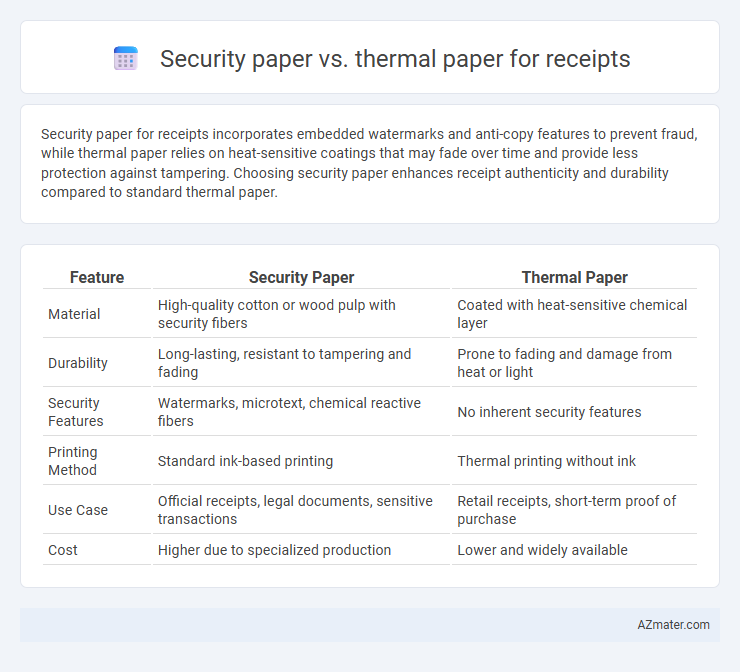Security paper for receipts incorporates embedded watermarks and anti-copy features to prevent fraud, while thermal paper relies on heat-sensitive coatings that may fade over time and provide less protection against tampering. Choosing security paper enhances receipt authenticity and durability compared to standard thermal paper.
Table of Comparison
| Feature | Security Paper | Thermal Paper |
|---|---|---|
| Material | High-quality cotton or wood pulp with security fibers | Coated with heat-sensitive chemical layer |
| Durability | Long-lasting, resistant to tampering and fading | Prone to fading and damage from heat or light |
| Security Features | Watermarks, microtext, chemical reactive fibers | No inherent security features |
| Printing Method | Standard ink-based printing | Thermal printing without ink |
| Use Case | Official receipts, legal documents, sensitive transactions | Retail receipts, short-term proof of purchase |
| Cost | Higher due to specialized production | Lower and widely available |
Introduction to Receipt Paper Types
Receipt paper primarily comes in two types: security paper and thermal paper, each designed for specific applications and durability. Security paper incorporates embedded features like watermarks and anti-copy patterns to prevent fraud and counterfeiting, making it ideal for sensitive transactions. Thermal paper uses heat-sensitive coating for image formation, offering fast, quiet printing but generally less durability and security compared to security paper.
What is Security Paper?
Security paper is specially designed material embedded with features like watermarks, microtext, or holograms to prevent forgery and unauthorized copying, commonly used for official documents and receipts requiring authentication. Unlike standard thermal paper, which relies on heat-sensitive coating for printing without intrinsic security measures, security paper ensures document integrity by making alterations detectable. This makes security paper ideal for high-value transactions, legal receipts, and sensitive information where tamper-evidence and verification are critical.
What is Thermal Paper?
Thermal paper is a specialized heat-sensitive paper coated with a chemical layer that changes color when exposed to heat, enabling printers to create images or text without ink. It is commonly used for receipts in point-of-sale systems due to its speed and quiet operation. Unlike security paper, thermal paper lacks built-in anti-counterfeiting features but offers cost-effectiveness and convenience for high-volume printing.
Security Features: Security vs Thermal Paper
Security paper incorporates advanced features such as watermarks, holograms, and ultraviolet (UV) markings to prevent counterfeiting and tampering, providing enhanced protection for sensitive receipts. Thermal paper relies on heat-sensitive coatings that darken upon exposure to heat but lacks intrinsic anti-fraud features, making it more vulnerable to forgery. For applications requiring high security and authentication, security paper offers superior safeguards compared to standard thermal paper.
Durability and Longevity Comparison
Security paper for receipts offers enhanced durability and longevity compared to thermal paper due to its chemical composition and protective coatings that resist fading, smudging, and environmental damage. Thermal paper, while cost-effective and widely used, tends to degrade quickly when exposed to heat, light, or oils, resulting in short-term readability issues. For applications requiring long-term document preservation, security paper remains the superior choice because it maintains clarity and resists tampering over extended periods.
Printing Technology Differences
Security paper employs advanced printing technologies such as microprinting, watermarks, and UV-reactive inks to enhance fraud prevention and document authenticity, making it ideal for sensitive receipts requiring verification. Thermal paper relies on heat-sensitive coatings that change color upon contact with thermal print heads, offering fast, cost-effective printing without ink but limited resistance to heat and light exposure. The core difference lies in security paper's integration of multi-layered security features through specialized printing methods, whereas thermal paper focuses on simplicity and speed via thermal chemical reactions.
Cost Analysis: Security vs Thermal Paper
Thermal paper typically incurs a lower initial cost compared to security paper, making it a budget-friendly option for high-volume receipt printing. However, security paper often justifies its higher price through enhanced features like tamper resistance and fraud prevention, reducing long-term risks and potential losses. When evaluating total cost of ownership, factors such as durability, reprint frequency, and fraud mitigation play critical roles in the cost-effectiveness of security versus thermal paper.
Environmental Impact and Sustainability
Thermal paper receipts often contain Bisphenol A (BPA) or Bisphenol S (BPS), chemicals harmful to the environment and difficult to recycle, contributing to pollution and health concerns. Security paper receipts, typically made from recycled materials and free of hazardous chemicals, offer a more sustainable alternative with better recyclability and reduced toxic waste. Choosing security paper supports eco-friendly business practices by minimizing chemical exposure and enhancing overall environmental impact.
Use Cases: Best Applications for Each Paper
Security paper is ideal for receipts requiring fraud prevention, such as medical prescriptions, financial transactions, and legal documents, due to its built-in features like watermarks, UV fibers, and tamper-evident patterns. Thermal paper excels in high-volume retail and hospitality environments, offering fast print speeds and clear text for receipts, tickets, and delivery slips. Businesses prioritize security paper when document authenticity is critical, while thermal paper is preferred for cost-effective, quick-printing solutions in everyday commercial use.
Choosing the Right Receipt Paper for Your Business
Security paper for receipts incorporates anti-copy and tamper-evident features, making it ideal for businesses requiring enhanced fraud prevention. Thermal paper relies on heat-sensitive coating for fast, high-quality prints but can fade over time and resists moisture poorly. Choosing the right receipt paper depends on your business needs: prioritize security paper for sensitive transactions and thermal paper for cost-effective, efficient printing.

Infographic: Security paper vs Thermal paper for Receipt
 azmater.com
azmater.com